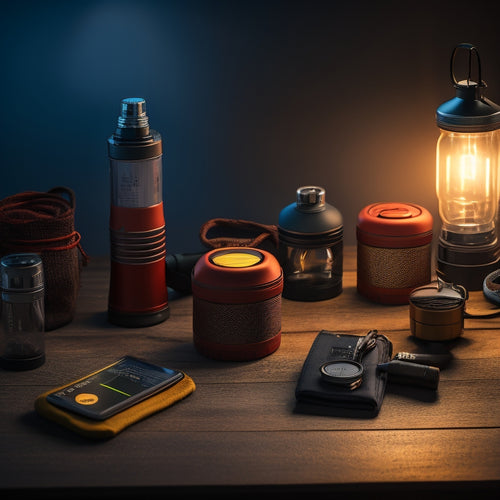
7 Home Battery Backup System Buying Tips
Share
When buying a home battery backup system, you'll want to assess your energy needs by reviewing past electricity bills and conducting an energy audit to identify high usage areas and efficiency opportunities. It's essential to understand battery types, including lithium-ion and lead-acid, and their differences in maintenance, cost, and environmental sustainability. You'll also need to evaluate system compatibility, backup power capacity, and manufacturer reputation, while considering budget constraints and warranty options. By doing your due diligence, you'll be well-equipped to make an informed decision; now, learn how to maneuver these complex factors to find the perfect system for your unique needs.
Key Takeaways
- Assess your energy needs by reviewing past bills, identifying peak usage periods, and accounting for seasonal variations and future demand increases.
- Choose a battery type based on your needs and priorities, considering factors like upfront costs, maintenance, and environmental sustainability.
- Ensure the system is compatible with your existing electrical infrastructure, wiring, and renewable energy sources, and consider remote monitoring features.
- Calculate your power needs by determining the total wattage of essential appliances and desired backup duration, and size the system accordingly.
- Evaluate the manufacturer's reputation, warranty options, and budget considerations, including upfront costs, maintenance fees, and expected replacement costs.
Assessing Your Energy Needs
When considering a home battery backup system, evaluating your energy needs is the vital first step. You need to determine how much energy you consume daily and during peak usage periods.
To do this, review your past electricity bills to identify your average energy consumption. Look for the highest usage periods, usually during summer or winter when heating and cooling systems are in use. Note the total watt-hours or kilowatt-hours used during these times.
It's also important to account for seasonal variations and potential future increases in energy demand, as this will impact the overall sizing of your system. By conducting a thorough energy audit, you can identify high usage areas and efficiency opportunities, which will help you optimize your system configuration.
This information will help you size your battery backup system accurately. You'll want a system that can handle your peak usage to guarantee uninterrupted power supply during outages.
Understanding Battery Types
You'll encounter various battery chemistry options when shopping for a home battery backup system, including lithium-ion, lead-acid, and others.
Within these categories, you'll also find different types of deep cycle batteries, each with its own strengths and weaknesses.
For instance, top-rated solar battery systems like SimpliPhi and Rolls-Surrette are popular choices for off-grid power.
As you evaluate your options, it's important to understand the key differences between lithium-ion and lead-acid batteries to make an informed decision.
Battery Chemistry Options
Picking the right home battery backup system involves diving into the world of battery chemistry, where different types of batteries cater to distinct needs and preferences.
As you investigate your options, you'll encounter various battery chemistries, each with its strengths and weaknesses.
Lead-acid batteries, for instance, are cost-effective and well-established but require regular battery maintenance and have a relatively short lifespan.
Lithium-ion batteries, on the other hand, boast high energy density and long lifetimes but come with a higher price tag and potential environmental impact concerns.
You'll need to weigh factors like upfront costs, maintenance requirements, and environmental sustainability to choose the battery chemistry that best fits your needs and priorities.
Types of Deep Cycle
As you consider the ideal battery chemistry for your home backup system, it's equally important to understand the different types of deep cycle batteries available. You'll find three main types: flooded, AGM, and gel batteries. Each has its strengths and weaknesses, which are summarized in the table below.
| Type | Maintenance Requirements | Cycle Depth | Discharge Rates |
|---|---|---|---|
| Flooded | High (water level checks, electrolyte maintenance) | Deep (80% DOD) | High (fast charging/discharging) |
| AGM | Low (no maintenance required) | Moderate (50% DOD) | Moderate (balanced charging/discharging) |
| Gel | Low (no maintenance required) | Shallow (30% DOD) | Low (slow charging/discharging) |
When choosing a deep cycle battery, consider factors like temperature effects and charging efficiency. Flooded batteries, for instance, are more sensitive to temperature fluctuations, while AGM batteries offer better charging efficiency. Gel batteries, on the other hand, are more suitable for shallow cycle applications.
Lithium-Ion Vs. Lead
Three primary battery types dominate the home battery backup system market: lithium-ion, lead-acid, and their variants.
When choosing between lithium-ion and lead-acid batteries, consider the following key differences:
-
Efficiency comparison: Lithium-ion batteries have higher round-trip efficiency (90-95%) compared to lead-acid batteries (80-85%). This means lithium-ion batteries waste less energy during charging and discharging.
-
Weight differences: Lithium-ion batteries are considerably lighter than lead-acid batteries, making them easier to install and transport.
-
Cycle life: Lithium-ion batteries have a longer cycle life (3,000-5,000 cycles) compared to lead-acid batteries (200-500 cycles).
- Self-discharge rate: Lithium-ion batteries have a lower self-discharge rate (2-3% per month) compared to lead-acid batteries (5-10% per month).
These differences will help you decide which type of battery best suits your home battery backup system needs.
Evaluating System Compatibility
When selecting a home battery backup system, confirming system compatibility is essential to guarantee seamless integration and peak performance.
You'll want to evaluate the system's integration with your existing electrical infrastructure, including the type of electrical panel and wiring. Check the installation requirements, such as the necessary space and environmental conditions, to facilitate a smooth installation process.
Additionally, assess the system's compatibility with your renewable energy sources, such as solar panels, and any smart home devices you may have.
It's also important to examine the system's remote monitoring features to guarantee real-time energy management and alerts.
Furthermore, evaluate the system's advanced battery management systems that enhance charging and discharging for improved performance.
Considering Backup Power Capacity
When buying a home battery backup system, you'll need to calculate your power needs to make certain the system can support your essential appliances during an outage. This involves identifying the total wattage of the devices you want to power and the duration you need them to run.
To optimize energy usage, consider your energy profile and peak demand periods energy independence, and assess your energy demands to determine the required energy storage for daily needs.
Calculating Power Needs
You'll need to determine the backup power capacity required for your home battery backup system, which involves calculating your power needs during an outage.
This calculation is vital to guarantee you have enough power to support your essential appliances and devices during an extended power outage.
To calculate your power needs, consider the following:
-
Total power usage: Add up the wattage of all the devices you want to power during an outage, including refrigerators, lights, and medical equipment.
-
Energy efficiency: Consider the energy efficiency of your devices, as some may require more power to operate than others.
-
Duration of backup power: Determine how long you want your backup power system to last during an outage, as this will impact the required capacity.
- Peak power demand: Identify the maximum power demand during an outage, as this will help you size your system correctly.
Sizing the System Right
By the time you've calculated your power needs, you're ready to size your home battery backup system correctly.
This involves determining the backup power capacity required to support your essential appliances during an outage. Consider the total wattage of devices you want to power, as well as the duration you need backup power for. A larger capacity system will provide longer backup times, but it'll also increase installation costs.
Be certain to factor in installation requirements, such as available space and electrical connections. Additionally, consider maintenance tips, like guaranteeing easy access to batteries for future replacements.
Battery Lifespan and Durability
The lifespan of a home battery backup system is largely dependent on the type and quality of the batteries used.
You'll want to take into account factors that affect lifespan, such as charging cycles, depth of discharge, and operating temperatures. Proper battery maintenance is essential to extending the lifespan of your system.
Follow these battery maintenance tips to get the most out of your investment:
-
Monitor battery health: Regularly check your battery's state of charge, voltage, and temperature to identify potential issues early.
-
Avoid deep discharging: Try to keep your batteries charged between 20% and 80% to minimize wear and tear.
-
Keep them cool: Make sure your batteries are installed in a well-ventilated area, away from direct sunlight and heat sources.
- Update your system software: Regularly update your system's software to guarantee you have the latest features and optimizations.
Manufacturer Reputation Matters
When selecting a home battery backup system, proper battery maintenance is only half the battle. You also need to evaluate the manufacturer's reputation, which can make or break your overall experience.
Look for brands with a proven track record of reliability, as evident in customer reviews and industry awards. A manufacturer with a strong service support system can provide timely assistance when you need it.
Additionally, brands that prioritize product innovation and minimize environmental impact are more likely to present high-performance systems. Check their warranty options, installation services, and maintenance requirements to verify they align with your needs.
Budget and Warranty Considerations
Considering your financial constraints, you'll want to determine how much you're willing to spend on a home battery backup system. This will help you narrow down your options and guarantee you're getting the best value for your money.
When making a cost comparison, consider the following factors:
-
The upfront cost of the system, including installation and maintenance fees.
-
Ongoing energy savings and potential rebates or incentives.
-
The system's lifespan and expected replacement costs.
- Warranty options, including duration, coverage, and support.
Frequently Asked Questions
Can I Install a Home Battery Backup System Myself?
You can attempt a DIY installation, but be aware that it's essential to prioritize safety considerations, as improper connections can lead to electrical shock, fires, or system failures, so consider seeking professional assistance to guarantee a safe and reliable setup.
Are Home Battery Backup Systems Environmentally Friendly?
You're wondering if home battery backup systems are environmentally friendly. They can be, as they promote energy efficiency by storing excess energy and reducing grid dependence, minimizing their environmental impact through reduced carbon emissions and fossil fuel consumption.
How Long Does It Take to Charge a Home Battery Backup System?
When you're "rushing against the clock," charging speed matters. The time it takes to charge a home battery backup system depends on the charging speed and battery capacity. Typically, a 10 kWh battery takes 2-5 hours to fully charge with a 3 kW charger.
Can I Use a Generator With a Home Battery Backup System?
You can use a generator with your home battery backup system, but verify generator compatibility and proper power management to avoid conflicts; this integration requires careful planning to optimize charging, backup, and grid-tie functionality.
Are Home Battery Backup Systems Compatible With Solar Panels?
As you traverse the intersection of renewable energy and backup power, you'll find that home battery backup systems are indeed compatible with solar panels, thanks to seamless solar integration, ensuring battery compatibility and a harmonious marriage of energy storage and generation.
Related Posts
-

Best Solar Powered Flashlights for Emergency Situations
When you're choosing the best solar-powered flashlights for emergency situations, focus on their brightness, battery ...
-

Essential Hiking Lights for Safety and Fun
When you're hitting the trails, essential hiking lights are vital for safety and fun. A lightweight headlamp offers h...
-

Smart Grid Technology Implementation Challenges
You'll encounter several challenges when implementing smart grid technology, particularly in cost management, scalabi...


